What's Ahead in Accommodative IOLs
Dual optic, deformable, injectable and other modalities are all being developed.
BY I. HOWARD FINE, M.D., RICHARD S. HOFFMAN, M.D., AND MARK PACKER, M.D.
|
|
|
|
Results for binocular implantation of the eyeonics crystalens from one FDA investigational site. (Image courtesy of Drs. Fine, Hoffman & Packer.) |
|
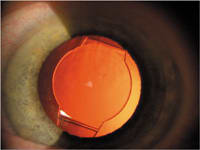
|
|
| An implanted eyeonics crystalens, 2 weeks post-op. (Image courtesy of Drs. Fine, Hoffman & Packer.) | |

|
|
| The HumanOptics IOL is continuing in clinical trials in Europe. (Image courtesy of HumanOptics.) | |
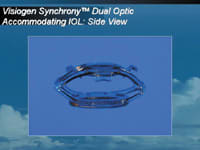
|
|
| A side view of the Visiogen Synchrony Dual Optic accommodating IOL. (Image courtesy of Visiogen and Samuel Masket, M.D.) | |

|
|
| The Sarfarazi IOL, currently licensed by Bausch & Lomb, is comprised of a minus-powered optic positioned posteriorly to a positive-powered optic joined by compressible bridges. (Image courtesy of Bausch & Lomb.) | |
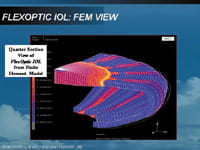
|
|
| A schematic of the FlexOptic IOL. (Image courtesy of AMO and John Hunkeler, M.D.) | |
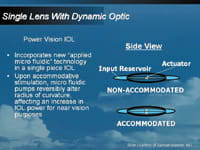
|
|
| Design and principle of the Power Vision IOL. (Image courtesy of Samuel Masket, M.D.) | |
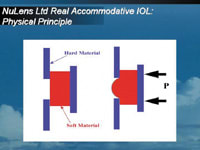
|
|
| Schematic demonstrating the physical principle of the NuLens. (Image courtesy of NuLens Ltd.) |
As we are all aware, the only accommodative IOL to have received FDA approval so far is the eyeonics crystalens. This silicone plate-haptic lens has a 4.5-mm optic and scoring of the haptic-optic junction to allow for retroplacement of the optic in a nonaccommodative state and forward movement at the hinge during accommodation. Our practice participated in the FDA-monitored clinical trials for this lens, and our results are shown in the chart to the right.
We have also used this lens in refractive lens exchange, achieving excellent visual acuity results, and measuring high patient satisfaction. Of 130 refractive lens exchange patients:
► 25.8% report not wearing spectacles at all
► 47.7% report that they wear spectacles almost none of the time
► 15.6% report wearing spectacles some of the time
► 6.3% report wearing spectacles most of the time
► 4.7% report wearing spectacles almost all the time.
Another accommodative lens, from HumanOptics, is continuing in clinical trials in Europe. (See image on next page.) We have not had any experience with this lens in the United States, but the mechanism of action is believed to be similar to that of the crystalens.
We are somewhat concerned that we have not been able to objectively demonstrate movement of either of these lenses, but we are certainly confident in the results we have achieved with the crystalens.
Several other accommodative IOLs are currently being developed and studied:
Dual-optic IOLs. Several dual-optic lenses are currently on the drawing board and in early clinical trials. The Visiogen Synchrony Dual Optic IOL, a one-piece, silicone lens, consisting of a high plus-powered (front) optic attached by flexible bridges to a low minus-powered (back) optic, fits within the capsular bag. (See image on next page.) In a nonaccommodated state, the distance between the two optics is shorter than in an accommodative state, when the bag slackens and the compressible haptics push the plus-powered optic forward. This lens has been implanted in more than 100 humans outside the United States, has undergone early clinical trials in Europe, and is approaching the start of U.S. clinical trials. Results from the most recent 20 monocular cases at 3 months showed:
► 95% of patients had >= 20/40 distance-corrected near visual acuity
► 86% of patients had >= 20/40 uncorrected visual acuity
► 100% of patients had >= 20/40 best-corrected visual acuity
► mean spherical equivalent was -0.79D.
A similar IOL, the Sarfarazi lens, has been licensed by Bausch & Lomb. (See image on this page.) It is also comprised of a minus-powered optic positioned posteriorly to a positive-powered optic, joined by compressible bridges.
Deformable IOLs. The Power Vision IOL has a fluid reservoir that allows for peripheral location of fluid in the nonaccommodative state, and the central movement of that fluid, increasing the curvature of the central portion of the optic, making it a more plus-powered lens on accommodation. (See "Single Lens with Dynamic Optic," below.)
The NuLens, designed in Herzliya, Israel, has a piston-like configuration that, with accommodative effort, compresses a central cylinder containing a flexible silicon gel encased within a deformable membrane. On accommodative effort, the change in the curvature of the anterior surface of the lens results in a marked increase in plus-power. (See image on next page). This is not unlike a naturally occurring lens in the eye of a merganser, a bird that can dive into water to catch fish. The merganser has a highly developed iris sphincter muscle, which varies the curvature of the front of the lens on accommodative effort, enabling it to have excellent vision in water, as well as in air. In early studies of the NuLens in monkeys, the lens was shown to be capable of an accommodative amplitude of more than 40 diopters.
The FlexOptic IOL involves not only forward movement of the plus-powered optic, but also a change in curvature of the optic as a result of accommodative effort. (See image above.) This axial travel of the optic plus the change in optic shape, with a 1.51 refractive index material, would achieve 4.5 diopters of accommodation.
Injectable polymers. Injectable polymers represent another potential avenue for the development of accommodative IOLs. At this time, several entities (including AMO and Groningen working with the polymer originally developed by Pharmacia; Medennium; Calhoun Vision; and Vision Sciences Research Cooperative) are investigating the injectable approach.
The Calhoun lens is a light-adjustable lens, which can be superimposed on the injectible polymer matrix, allowing for changes in plus or minus power as well as toricity. This means refinements can be made with laser devices after the lens has been implanted in the eye. This modality also offers the possibility of correcting for higher-order aberrations in the cornea. (See image on next page.)
The SmartIOL, a thermodynamic accommodating IOL, is being studied by Medennium. This lens is capable of custom manufacture to fill the capsular bag, which would eliminate edge effects and decentrations. (See image above.) It is convertible at room temperature to a thin rod, which can be injected into a normal-sized capsulorhexis, making lens extraction more routine than with other injectable polymer lenses. Under the influence of body temperature, the lens reconfigures to its original size, shape, and imprinted dioptic power. This is a stable gel at body temperature; therefore, a YAG laser procedure could be performed without spillage of the lens material into the vitreous body.
Microincision lens. Lenstec is developing the Tetraflex accommodating IOL, an acrylic, square-edged, one-piece microincision lens with equiconvex optics. (See image above.) The company says that unique haptics and a 5-degree anterior angulation allow the lens to move forward during the accommodating process. The optic acts like a sail in the wind, catching the wave of the vitreous. Doctors who have implanted the lens are reporting 2.5D to 3.5D of accommodation at 6 months to a year.
A phakic approach. The Vision Membrane lens is an anterior chamber phakic IOL. It is multiordered and diffractive (polychromatic) and is capable of expanding the depth of focus of each wavelength of light to achieve near as well as distance and intermediate vision.
The field of accommodative IOLs is rapidly advancing, and we anticipate that fabulous new options will be available in the near future.
At the Casey Eye Institute at Oregon Health & Science University in Portland, Dr. Fine is a clinical professor, Dr. Packer is a clinical assistant professor, and Dr. Hoffman is a clinical associate professor. Their practice, Drs. Fine, Hoffman & Packer, LLC, is located in Eugene, Ore.

|
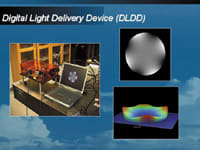
|

|
| The SmartIOL completely filling the capsular bag in a human cadaver eye. (Image courtesy of Medennium) | This prototype digital light delivery device can be used to correct a tetrafoil aberration in the cornea by altering the Calhoun injectable polymer IOL. A three-dimensional color diagram of the altered lens is also shown. (Image courtesy of Calhoun Vision.) | The Tetraflex is an acrylic one-piece microincision lens with equiconvex optics. |









